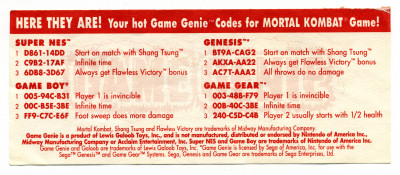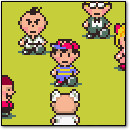[ Retro Scan of the Week ] Game Genie Update Flyer
May 7th, 2012 by Benj Edwards HERE THEY ARE! Your HOT Game Genie CODES for MORTAL KOMBAT!
HERE THEY ARE! Your HOT Game Genie CODES for MORTAL KOMBAT!
I picked up this 5-inch by 2-inch Game Genie flyer/note at a local store (probably Toys’R’Us or K-Mart) in the early 1990s. Back then, Galoob printed up pads of these miniature flyers that would then be attached to retailer shelves near new games for sale. The pads looked much like office note blocks; a hard dry layer of glue covered the top side of the stack, allowing people to pull the flyers off one at a time.
I presume that Galoob distributed these flyers to stores as marketing tools. Since newly released games did not appear in Game Genie code books printed years before (such was the case with Mortal Kombat, seen here), these flyers provided an opportunity to both prove that the Game Genie was still relevant and to also to suggest the benefits of owning a Game Genie (“wow, infinite lives!”) to people buying the game.
While I owned a Game Genie when I acquired this historical morsel, I’m pretty sure I didn’t own Mortal Kombat at the time. I grabbed the flyer because I saved anything and everything video game related that I could get my hands on, which is why I still have it today.
Discussion Topic of the Week: Do you remember seeing flyers like this in stores? Tell us about your experience.






May 7th, 2012 at 10:40 pm
I never had a Game Genie for any system, nor did I ever see any of these pamphlets. But this post clicks another piece of the puzzle into focus. I knew that there are essentially unlimited code possibilities with the Game Genie but I didn’t understand how they could communicate new codes for new games in the pre-internet era.
May 8th, 2012 at 1:10 pm
Multimedia Mike,
Probably the most common way Game Genie codes were distributed was in video gaming magazines.
May 13th, 2012 at 3:52 pm
Why is there a code that is only “usually” effective? From the Game Gear version, “Player 2 usually starts with 1/2 health.”
May 13th, 2012 at 5:35 pm
Zoyous, my best guess would be that there was more than one revision of the Mortal Kombat GG program out there (that was actually pretty typical for cartridge games), so the GG code would work with one version of the game and not with another.